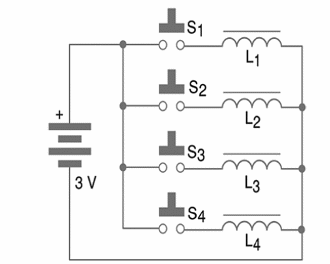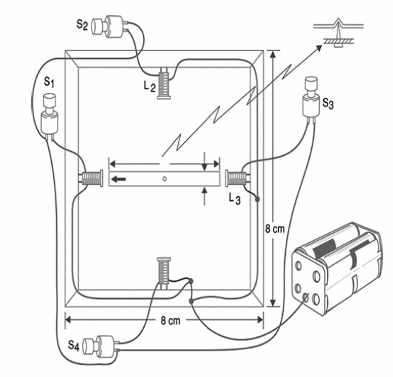Note: this project is part of my book Science Fair and Technology Education Projects.
It is an interesting project for science fairs or as practical work in Technology Education, like Mechatronics. The game has a metal spin (that can be attracted by magnets) with 4 small electromagnets placed near it. Spinning the device, when the referee says “now!”, or when a lamp turns on, the players have to press their buttons, powering the electromagnets up.
Only one will attract the spin, which will stop, pointing its position. The pointed one is the winner. An interesting fact is that the circuit is random. It means that there is a possibility of the pointed position being exactly opposite to the one who first pressed the switch.
The circuit is powered by common cells. Their life will be long since they are used only for a short time interval when the players press the buttons. Building the device requires some skill to work with mechanical parts, since much more mechanic parts are used than electronic ones. Figure 1 shows the schematic diagram of the device.

Figure 2 shows the final aspect of the building. The reader is free to change this layout according to his imagination and skills.

The spin is made of a piece of metal blade (the metal must be any ferrous type, to be attracted by the electromagnets). Aluminum or copper can’t be used since they are not attracted by magnets. The spin is balanced on a nail. It has to rotate freely when you use your fingers to spin it.
Any of the four small electromagnets are formed by 100 to 300 turns of enameled wire 30 to 32 AWG on a small nail (5 cm to 7 cm long). Remove the enamel cover of the wire in the connection points to the push buttons and the cell holder. The wires to the push buttons must be long to make it easier to use.
To play you have to:
- Turn the spin using your fingers to rotate it.
- Each competitor must be with their push button ready to be pressed.
- When the referee gives the order, all the competitors must press the push button.
- The winner is the one to whom the spin points when it stops.
Before playing, test the device by verifying if all the electromagnets are in operating condition.
Competition:
- Organize competitions to see who knows more about a certain subject. Use the device to detect the one who wants to answer the question first.
B1—4 AA or C cells with holder
S1 to S4—push buttons NO (normally open)
L1 to L4—electromagnets — see previous text
Other:
Wooden base, metal blades, nails, wires, solder, etc.




